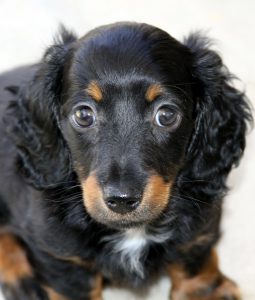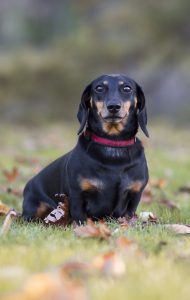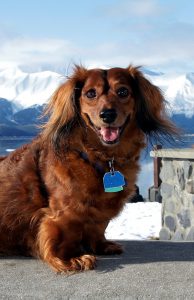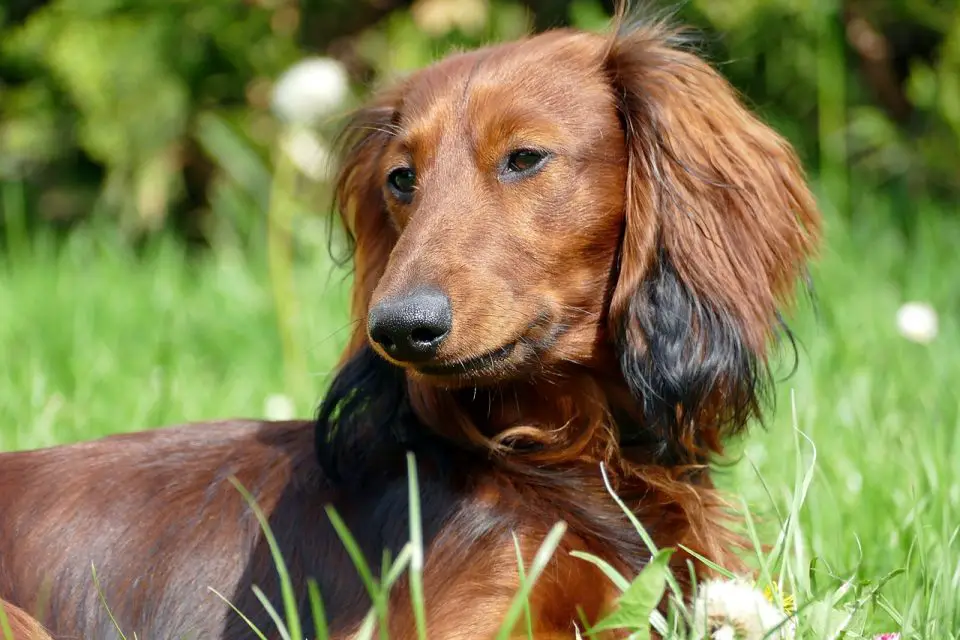Hi, my name’s Irena and my dog, Sherlock, sheds like mad. He’s a mixed breed and has quite long and wavy hair. I am forever sweeping up his hair, but half an hour after I’ve swept up, there’s more hair!
Mind you I still love him more than anything and wouldn’t be without him.
Shedding can be a big problem and in this article, we will concentrate on whether or not Dachshunds shed and what you can do about it. Don’t despair, there are lots of solutions.
What Constitutes Shedding in Dogs
So what exactly is shedding? Well, it happens when your dogs lose their dead and damaged hair, making room for new and healthy hair to grow.
How much hair is shed depends on the breed and also the health of your dogs.
If your dogs seem to be shedding more than usual and their skin is becoming irritated, there could be a medical condition causing this.
The best thing to do is to take your dogs to the vet and see if there is an underlying problem.
Some dogs shed all the time like my Sherlock. Others shed seasonally, usually in the summer, while others hardly shed at all.
If you suffer from allergies it would better to pick short-haired dogs as they tend to shed the least. Generally, dogs with long and silky coats shed the most, although as you will see this is not always the case.
Some breeds of dog are known to be high shedders; for example Labradors, Siberian Huskies, Chow-Chows and Saint Bernard’s.
Others are known to be low shedders, like Irish and Australian Terriers, Yorkshire Terriers and Maltese dogs.
Some designer breeds like the Goldendoodle are sold as being ‘non-shedding’ and hypoallergenic, but this can’t be guaranteed. The majority of dogs do shed even if it’s just a little bit.
Do Dachshunds Shed?
 Dachshunds are moderate shedders, but there are three different types of this breed and they do vary in the amount they shed.
Dachshunds are moderate shedders, but there are three different types of this breed and they do vary in the amount they shed.
There are three types of coat that Dachshunds can have; long-haired, short-haired and wirehaired.
Short-haired Dachshunds have less undercoat then the other two varieties meaning that they will shed the least.
Long-haired Dachshunds have slightly wavy hair and long outer coats. They also have undercoats which have pros and cons.
The good thing is that the undercoats keep your Dachshunds warm when it is cold outside. However, undercoats are the main cause of shedding.
Wire-haired Dachshunds also have undercoats, but because they are wiry, they don’t shed as much as the long-haired variety.
Dachshund Shedding: Are Dachshunds Hypoallergenic?
Many people are allergic to both dogs and cats. Research has shown that around 10% of the population in the US is allergic to dogs.
A lot of people think that it is the fur or hair from the dogs that cause allergies to develop. However, this isn’t the case.
It is actually the dander in the fur which causes the allergies. In addition, some allergies are caused by proteins which are produced in the saliva.
All dogs have these proteins, even hairless dogs and ones that shed only a little.
Owners of short-haired and wire-haired Dachshunds claim that their dogs are hypoallergenic because they don’t produce that much dander, but are they right?
Another thing that they claim is the fact that their Dachshunds are small and so don’t produce as much dander as a medium or large dog would.
However, all dogs do shed a little so you can’t say that Dachshunds are completely hypoallergenic.
There are things that you can do at home to lessen the effect of allergies. The first thing to do is to buy a pet vacuum.
They are specially designed to pick up hair and dander and are a lifesaver. If you have time, it is a good idea to clean the areas where your dog is on a daily basis.
In addition, there are dander and allergy air purifiers available, so it is a good idea to buy a few of these for all the rooms your Dachshunds go into.
Another idea is to bathe your dog a couple of times a week. Use an anti-allergen shampoo which can help to reduce the amount of dander produced by your dog.
Do ‘Hypoallergenic’ Dogs Exist?
You will find many articles on the internet and in magazines stating that there are hypoallergenic dogs, but can this be believed?
Quite often the dogs who are supposed to be hypoallergenic are the ‘designer’ breeds. However, do they really not produce any dander or protein in their saliva? The answer is no.
In my opinion, there’s no such thing as a completely hypoallergenic dog. Yes, there are dogs which shed minimally, but not ones that don’t shed at all.
Generally, dogs that don’t shed much are considered hypoallergenic, but they still have allergen proteins in their fur. However, because they shed very little, there is hardly any dander to cause allergies.
Are Dachshunds Good for People with Allergies?
Short-haired Dachshunds or wire-haired Dachshunds could be suitable for people with allergies as long as you take other precautions like vacuuming often, grooming and bathing your dogs.
However, long-haired Dachshunds probably aren’t the way to go if you develop allergies easily.
If you are dead set on having a long-haired Dachshund even if you do have allergies, it is essential that you do take these precautions otherwise you might find it hard sharing your home with your pet.
What Allergies can Dachshund Trigger?
 It is very common for people with other allergies or asthma to develop an allergy when they come into contact with Dachshunds.
It is very common for people with other allergies or asthma to develop an allergy when they come into contact with Dachshunds.
It can be very upsetting to find that you are allergic to your dogs. I know I would hate it if I found I was allergic to Sherlock. Sometimes allergies can suddenly come on even if you’ve had your dogs for a while.
If you suffer from allergies your immune system is usually very sensitive. In some people, it can cause reactions as soon as a bit of dander lands on them.
Proteins in the saliva can also cause allergies to develop and this can’t be eliminated by grooming.
The most common allergies Dachshunds can cause are itching of the skin, a blocked up nose and inflamed eyes. Itchy eyes are very common as you can just stroke your Dachshunds and then touch your eyes.
If your Dachshunds lick you or accidentally scratch you, your skin can become red very easily. If you only have minor allergy attacks, it can take a few days for the symptoms to develop.
It is possible to inhale dander and other particles from your Dachshunds. This can cause breathing problems when the particles enter your lungs.
You could experience shortness of breath, wheezing and coughing within just 15 minutes.
Another reaction to inhaling particles is a rash on the upper chest, neck and face.
For those who have asthma, you might suddenly have an attack and you will have to have your inhaler on hand. Probably if you do have asthma you should stick with short-haired Dachshunds.
Dealing with Dachshunds Shedding
So what do you do to lessen the effect of your Dachshunds shedding? Well, first you can brush your pet.
By brushing you will be removing any dead hair from your dogs before there is a chance of it getting on your clothes and furniture.
You can buy special brushes which are made for dogs that shed a lot. You will probably need one of these if you have long-haired Dachshunds.
The second thing to do is to make sure that your Dachshunds are getting enough moisture in their diet. It’s not a good idea to just serve them dry food as it can make their skin itchy and their hair can start falling out.
This is especially true for dry food which contains a lot of empty fillers like wheat, corn and soy.
Try mixing in some wet food with the dry. In addition, instead of giving them dog treats which are often dry, try them on some fruits and vegetables.
Deseeded melons, carrots and green beans are all good choices as they have plenty of moisture. Always make sure that your Dachshunds have access to a bowl of clean, fresh water as well.
Bathing your Dachshunds is another option to help stop them from shedding. Of course, this can be a hard task with some dogs.
I struggle with my Sherlock as he hates water. I usually end up wetter than him so I’m afraid I’ve almost given up on it.
The reason bathing is a good idea is that it removes matted hair before it has time to fall off and spread dander everywhere.
You can even buy special shampoos and conditioners which help to stop your dogs from shedding.
However, before you start shampooing your Dachshunds, have a word with your vet.
Too much shampooing can result in itchy and dry skin and it can even strip the fur of natural oils. Your vet will be able to recommend how often to bathe your dogs.
Keep a lint roller handy at all times as this can help to remove the dander from your Dachshunds. A vacuum is also essential.
Using it daily will stop a big build-up of dander. Another thing to do is put a blanket over the couch before you sit down with your dogs for a cuddle while watching TV.
I have blankets on both my couch and the armchairs. It is amazing how much hair gets deposited, but better on the blankets than the actual furniture.
With that much hair being shed you’d think Sherlock was bald, but he’s far from it. He always looks as if he has a full body of hair.
How to Reduce Dachshund Shedding – Grooming Advice
 The sort of brush you use depends on what type of Dachshunds you have.
The sort of brush you use depends on what type of Dachshunds you have.
If you have a short-haired dachshund a grooming mitt is a good idea. They don’t need to be brushed daily. Once or twice a week is adequate.
If you have long-haired Dachshunds you should brush them daily as they will be producing more dander. A bristle brush is the best choice for these Dachshunds.
They remove shedding hair from both the outer coats and the undercoats.
Long-haired Dachshunds are more prone to getting tangles and for them use a wire pinned brush. You will notice the difference on your furniture in no time.
Wirehaired Dachshunds are harder to groom. They might not shed as much as long-haired Dachshunds, but their hair can easily become tangled at the same time as new hair is growing.
You should use a slicker brush which is a brush which has wire or steel pins instead of bristles. Brush your dogs in the direction of their hair.
Wirehaired Dachshunds have bushy eyebrows, bushy beards and bristly undercoats so they need to be groomed slowly and gently so as not to hurt them.
For the best results, they should be brushed every few days. They also need to be taken to a professional groomer to have their beards and eyebrows trimmed.
Alternatives to Dachshunds – Do Any Other Dogs Shed Less?
If you do have allergies and you are set on having a dachshund you can choose a short-haired dachshund. However, there are plenty of other dogs that hardly shed at all so there are other options.
One breed of dog that doesn’t shed much is the Brussels Griffon. There are two types of Brussels Griffons; the wirehaired and the smooth-coated.
Neither sheds that much except through regular grooming. However, if you clip the hair of wirehaired Brussels Griffons it may cause a little extra shedding.
Another dog which doesn’t shed much is the Chinese Crested dog.
Again, there are two types of this dog; the Powderpuff which has a full head of hair and the Hairless which only has hair on the head, tail and feet.
The Hairless doesn’t shed much and surprisingly the Powderpuff doesn’t shed much either despite having a lot of hair.
Italian Greyhounds have very short hair and barely shed at all. In fact, they often need to wear jumpers in the winter to stop them from getting cold.
The reason they don’t shed much is that they don’t have an undercoat. Still, they should still be brushed once a week with a rubber brush. If you bathe them, use a conditioner.
Komondors are very unusual and unique dogs. They look like they have dreadlocks all over their bodies.
As puppies they have a soft coat which begins to curl, but by the age of two, they have thick tassels and cords.
You might think that because of this they would shed a lot and yes they might occasionally lose a whole cord, but they don’t shed in the normal sense of the word.
The Lowchen or Little Lion has a dense coat which is quite wavy and long. However, it surprisingly doesn’t shed much.
They should still be groomed to prevent them from getting tangled and matted hair which will be very uncomfortable for the dogs.
Another dog which has curly hair and doesn’t shed much is the poodle. They have single coats rather than double which often means that shedding is at a minimum.
Poodles have been used to create designer dogs like the Labradoodle (Labrador Retriever and Poodle) and the Schnoodle (Poodle and Schnauzer).
A lot of people will say that designer dogs are hypoallergenic, but no dog is completely hypoallergenic. Having said that, the less the dog sheds the less chance there is of allergies developing.
Portuguese Water Dogs do have long coats, but they don’t have an undercoat so shedding is kept to a minimum. They do need to be groomed however as their hair will just keep growing.
Yorkshire Terriers are another long-haired breed which sheds very little. Their hair too keeps growing so they need to be groomed.
Some people keep Yorkshire Terriers with a long coat; others have them groomed so that their coat is short. Either way, they hardly shed at all.
The unusually named Xoloitzcuintli is another dog that sheds very little.
There is a hairless version, but there is also one with a coat. Both barely shed at all, but the coated one needs to be brushed and bathed.
Final Thoughts: Do Dachshunds Shed
 I think that from this article we can deduce that there really isn’t a dog which doesn’t shed. However, there are some which shed minimally or only when brushed.
I think that from this article we can deduce that there really isn’t a dog which doesn’t shed. However, there are some which shed minimally or only when brushed.
When it comes to Dachshunds, the short-haired and wirehaired varieties shed the least. If you get a long-haired Dachshund, expect some shedding.
If you suffer from allergies it is probably better to not get long-haired Dachshunds as they could bring on your allergies.
With all types of Dachshunds, grooming is important as this keeps shedding to a minimum. By brushing you remove all the dead hairs and fur.
Brushing and bathing should be part of your routine, as should be vacuuming. If you take all these precautions you will have a fantastic life with your Dachshunds and who doesn’t want this?
